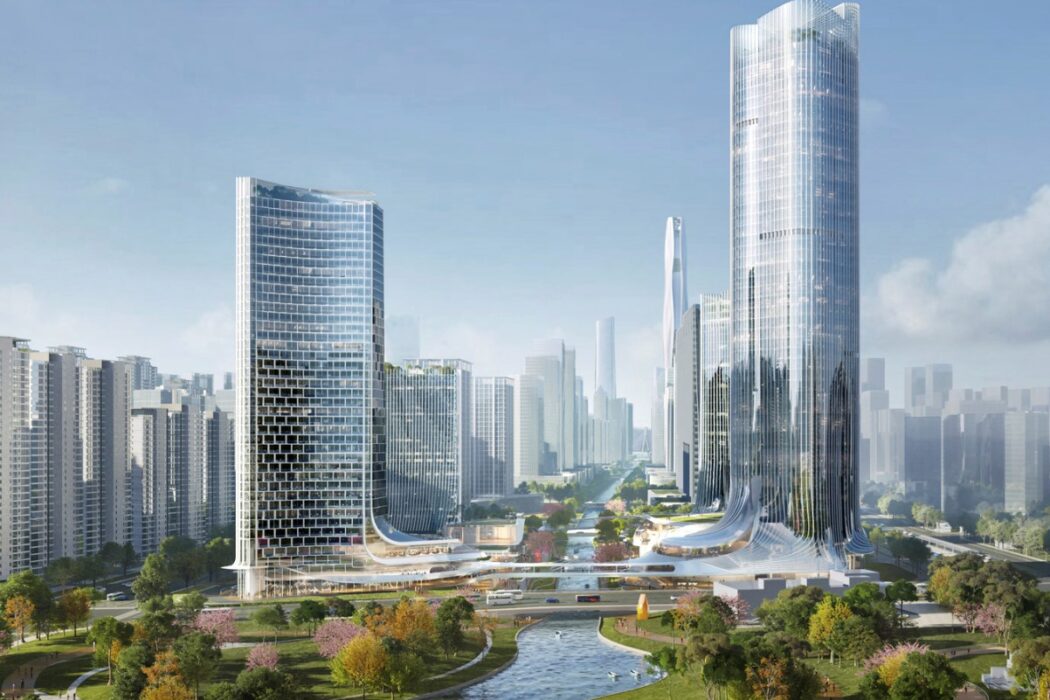In Nanjing, China, a visionary project with the distinctly non-visionary name Nanjing K.Wah G72 is expected to be one of the most expansive and revitalizing mixed-use redevelopment efforts ever seen in the city. It would reconnect neighborhoods, greatly increase city center residents, and restore a life-giving urban river and greenspace.
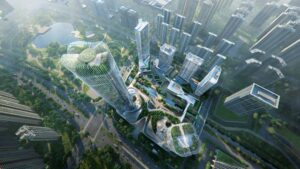 The Amsterdam-based design firm UNStudio has been commissioned by the developer K.Wah Group to create a lifestyle, 24/7 destination that features smart offices, luxury hotels, residential buildings, and art and culture facilities.
The Amsterdam-based design firm UNStudio has been commissioned by the developer K.Wah Group to create a lifestyle, 24/7 destination that features smart offices, luxury hotels, residential buildings, and art and culture facilities.
Phased across multiple plots, the integrated site is defined by a central waterway that acts as the social spine of the development.
UNStudio’s proposed design concept envisions a dynamic waterfront community, a low-density and lush green working-living environment, which is expected to add new vibrancy to Nanjing, while contributing as a hub for culture, finance and innovation.
Responding to Urban Planning
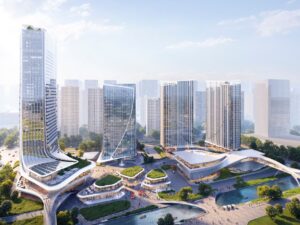 The Nanjing Hexi New District is one of the core new hybrid city centers built by the government, and aims to become a second Lujiazui area in China.
The Nanjing Hexi New District is one of the core new hybrid city centers built by the government, and aims to become a second Lujiazui area in China.
This new K.Wah G72 mixed-use project is a key development within the Hexi New District. It will also be a new milestone for the K. Wah Group’s redevelopment work in the Yangtze River Delta.
The project is set along the urban central and the economic development axes in Hexi New District, and is connected to the Metro Rail Transit to the northwest and the coast to the south.
The site is separated by the central river and the planned road into 4 plots, requiring a rational layout for retail spaces, hotel, offices and cultural functions that connect users across the entire site, and create a dynamic community for locals and visitors.
Ranging from 150 meters to 250 meters in height, the high-rise office towers located and neatly laid out to the north of the waterway, are designed to overlook the Hexi New District skyline, while commercial and cultural functions in the lower stories form a connection between the buildings and the street level.
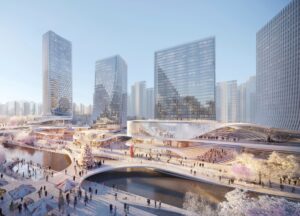 The other four towers on the opposite side of the river, feature two serviced apartment buildings, a headquarter tower and a luxury hotel.
The other four towers on the opposite side of the river, feature two serviced apartment buildings, a headquarter tower and a luxury hotel.
The redevelopment also includes a green waterfront public platform, low-density commercial podiums and cultural venues. This programming forms an urban silhouette that rises from the central waterfront area to either side of the complex.
A green corridor is extended throughout the entire design for K.Wah G72, bringing together community and nature in a multi-dimensional way.
Together with UNStudio’s landscape consultant, the team designed a holistic greening strategy that will be an indispensable part of Nanjing’s green network and will contribute to the well-being of the city.
Waterfront community
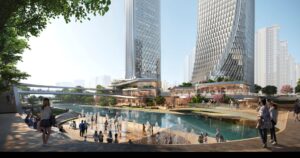 Creating a “lifestyle waterfront community” is at the core of UNStudio’s proposal for the K.Wah G72 mixed-use development.
Creating a “lifestyle waterfront community” is at the core of UNStudio’s proposal for the K.Wah G72 mixed-use development.
The communities that have historically lived by Nanjing City’s Qinhuai River inspired the design. By making full use of the resources along this central waterway, riparian low-density podiums and green terraces create a waterfront community that continues this cultural and urban heritage.
Hannes Pfau, a partner at UNStudio says, “UNStudio’s vision is set to realize a future-oriented, multi-purpose community, which will contribute to Nanjing’s ambitious urban development goals. The design aims to create a synergy between building scale and human scale, bringing a healthy and pleasant working, shopping and living environment for residents, visitors and creative professionals. The development will offer diversified value to this historical location, in terms of a new identity for the community and city.”
Enlivening the public spaces
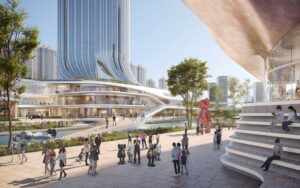 The design for the K.Wah G72 redevelopment focused on optimizing the use of the public spaces. The towers are spread across the four corners of the site to maximise interaction with the central waterfront, which serves as a placemaking element for all users.
The design for the K.Wah G72 redevelopment focused on optimizing the use of the public spaces. The towers are spread across the four corners of the site to maximise interaction with the central waterfront, which serves as a placemaking element for all users.
All green public spaces encourage socializing, event organization and creativity, and enable building users, visitors and creative professionals to experience new ways of living, while also providing a leisurely sanctuary to a fast-paced life.
UNStudio took a human-centric approach to its design when programming the retail podiums. At the intersection of the main waterway and green platforms, this area promotes a distinct garden-like shopping-living experience.
Designed to frame surrounding monuments, multiple portals at the retails, lower sections of the towers and cultural venues, blur the line between the interior and exterior. As such, they generate a dynamism that encourages users to interact with the architecture and amongst themselves.
The orientation of the office towers, hotel and apartment blocks with riverfront views brings optimal day light into the buildings.
Biophilic design elements are also permeated into interiors through the glass façade, which bring a sense of calm into the everyday lives and work of the end users.
The buildings have been linked horizontally and vertically through three layered routes: an annular landscape pedestrian bridge, a ground-level corridor and an underground passageway that connects to the metro.
“The Nanjing K.Wah G72 mixed-use development will serve as a one-stop destination in which lifestyle, innovation and work are brought together. It aims to be a benchmark for newly integrated urban developments in Nanjing, across the country, and beyond,” says Ben van Berkel, UNStudio’s Founder and Principal Architect.
These routes increase accessibility and facilitate connectivity within the community, while providing various communal platforms at all levels.
Cultural continuity
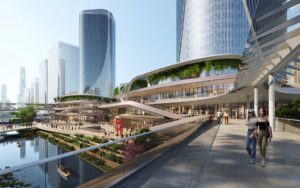 This waterfront community as well propels Nanjing and the surrounding regions as an exciting cultural venue. As the ancient capital of the six Chinese dynasties, Nanjing has a rich cultural history.
This waterfront community as well propels Nanjing and the surrounding regions as an exciting cultural venue. As the ancient capital of the six Chinese dynasties, Nanjing has a rich cultural history.
UNStudio’s design strategy for K.Wah G72 development adopts this history and incorporates it into the city’s embrace of contemporary art.
As such, the UCCA Centre for Contemporary Art, with approximately 5000 square meters, will be introduced and form the core public space for the arts within the community and will provide a new venue to showcase Nanjing’s culture and art on the world stage.
The streamlined and rhythmic design of the Art Centre supports a sense of togetherness within the community and fosters a more creative atmosphere. The transparent glass façade reflects the open, welcoming and inclusive nature of the design, attracting a wider public audience to the contemporary cultural venue.
The amphitheater acts as another public realm; a destination for social and performance set within the development.
In the future, the art venue will host a variety of international cultural and artistic events, exhibitions and social activities, creating a new, ambitious cultural venue that innovatively intertwines public and semi-private program for visitors and the general public alike.
Sustainability
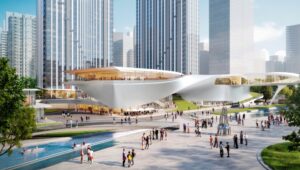 The proposal for K.Wah G72 aims to be a landmark in sustainability and future-proof design in China. Well-being is at the centre of the design, as well as the incorporation of technology to enhance the sustainability, public welfare and adaptive nature of the different plots.
The proposal for K.Wah G72 aims to be a landmark in sustainability and future-proof design in China. Well-being is at the centre of the design, as well as the incorporation of technology to enhance the sustainability, public welfare and adaptive nature of the different plots.
From the outset, UNStudio’s design strategy adopted active energy saving technologies, such as natural ventilation, HVAC system, solar photovoltaic panels (roof or facade), to lower the energy demands of the building. The office towers will also use prefabricated components as well as a modular supporting structure.
In order to ensure the effective introduction of natural air circulation into the towers, the design is set to apply slit ventilators to the office towers and apartment buildings. These will be integrated into the curtain wall units, which, to a large extent, will help prevent safety risks associated with the long-term use of high-rise buildings.
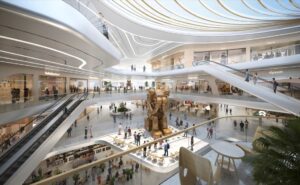 In addition, Building Integrated Photovoltaic (BIPV) solutions installed on the roofs of all buildings will meet the daily energy demand of the buildings and further reduce operation and maintenance costs. This solution will also be applied to the façade of UCCA Centre for Contemporary Art.
In addition, Building Integrated Photovoltaic (BIPV) solutions installed on the roofs of all buildings will meet the daily energy demand of the buildings and further reduce operation and maintenance costs. This solution will also be applied to the façade of UCCA Centre for Contemporary Art.
With its proximity to the central river, the development also introduces a rainwater management system to promote rainwater harvesting and irrigation, with the aim of forming a healthier ecosystem.
The sustainable design of the G72 development also focus on achieving a low carbon environment. It proposes a multi-layer transportation network, including a direct connection with the underground public transport system.
This not only provides convenience to visitors, but also encourages the use of public transport and increases regional accessibility. At the same time, by introducing separate waterfront footpaths and pedestrian bridges, walkability is promoted throughout the site.
As such, the design for K.Wah G72 will not only fulfill the needs for redeveloping the city center, but sets a precedence for mixed-use typologies as part of China’s goals for becoming carbon-neutral by 2060.
All images courtesy of UNStudio.

